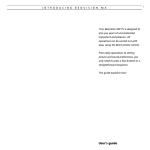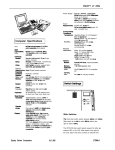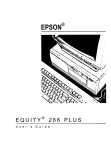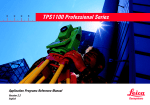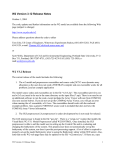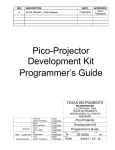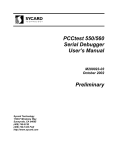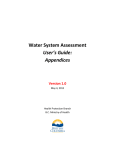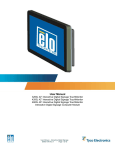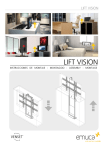Download Epson Equity LT-286e Parts User Manual
Transcript
EPSON®
EQUITY™LT™-286e
System Diagnostics
User’s Guide
IMPORTANT NOTICE
DISCLAIMER OF WARRANTY
Epson America makes no representations or warranties, either express or implied, by
or with respect to anything in this manual, and shall not be liable for any implied
warranties of merchantability and fitness for a particular purpose or for any indirect,
special, or consequential damages. Some states do not allow the exclusion of
incidental or consequential damages, so this exclusion may not apply to you.
COPYRIGHT NOTICE
All rights reserved. No part of this publication may be reproduced, stored in a
retrieval system, or transmitted, in any form or by any means, electronic, mechanical,
photocopying, recording, or otherwise, without the prior written permission of Epson
America, Inc. No patent liability is assumed with respect to the use of information
contained herein. While every precaution has been taken in the preparation of this
publication, Epson America assumes no responsibility for errors or omissions. Nor is
any liability assumed for damages resulting from the use of the information contained
herein. Further, this publication and features described herein are subject to change
without notice.
TRADEMARKS
Epson is a registered trademark of Seiko Epson Corporation.
Equity and LT are trademarks of Epson America, Inc.
MS-DOS is a registered trademark of Microsoft Corporation.
Copyright 0 1989 by Epson America, Inc.
Torrance, California
ii
Y19499100200
Contents
Introduction.. . . . . . . . . . . . . . . . . . . . . . . . . . . . . . . . . . . . . . . . . .
Starting the Diagnostics Program. . . . . . . . . . . . . . . . . . . . . . . . . . .
Creating a Database . . . . . . . . . . . . . . . . . . . . . . . . . . . . . . . . . . . . .
The DIAG Main Menu Screen . . . . . . . . . . . . . . . . . . . . . . . . . . . .
Selecting Diagnostics Tests . . . . . . . . . . . . . . . . . . . . . . . . . . . . . . .
Setting the Run Time Parameters . . . . . . . . . . . . . . . . . . . . . . . . . .
Timebound Testing . . . . . . . . . . . . . . . . . . . . . . . . . . . . . . . . .
Continuous Testing . . . . . . . . . . . . . . . . . . . . . . . . . . . . . . . . .
Passbound Testing . . . . . . . . . . . . . . . . . . . . . . . . . . . . . . . . . .
Error Logging.. . . . . . . . . . . . . . . . . . . . . . . . . . . . . . . . . . . . .
Executing Diagnostics Tests in Batch Mode . . . . . . . . . . . . . . . . . .
Running the Tests. . . . . . . . . . . . . . . . . . . . . . . . . . . . . . . . . . . . . . .
System Board Diagnostics . . . . . . . . . . . . . . . . . . . . . . . . . . . . . . . . .
Basic Functionality Test . . . . . . . . . . . . . . . . . . . . . . . . . . . . .
CPU Protected Mode Test. . . . . . . . . . . . . . . . . . . . . . . . . . . .
Processor Speed Test . . . . . . . . . . . . . . . . . . . . . . . . . . . . . . . .
Coprocessor Test . . . . . . . . . . . . . . . . . . . . . . . . . . . . . . . . . . .
DMA Controller Test . . . . . . . . . . . . . . . . . . . . . . . . . . . . . . .
Interrupt Controller Test. . . . . . . . . . . . . . . . . . . . . . . . . . . . .
Timer Test . . . . . . . . . . . . . . . . . . . . . . . . . . . . . . . . . . . . . . . .
RTC Test . . . . . . . . . . . . . . . . . . . . . . . . . . . . . . . . . . . . . . . . .
CMOS Validity Test . . . . . . . . . . . . . . . . . . . . . . . . . . . . . . . .
Memory Diagnostics . . . . . . . . . . . . . . . . . . . . . . . . . . . . . . . . . . . . .
BIOS ROM Test . . . . . . . . . . . . . . . . . . . . . . . . . . . . . . . . . . .
Parity Test . . . . . . . . . . . . . . . . . . . . . . . . . . . . . . . . . . . . . . . .
Pattern Test . . . . . . . . . . . . . . . . . . . . . . . . . . . . . . . . . . . . . . .
Walking 1’s Test. . . . . . . . . . . . . . . . . . . . . . . . . . . . . . . . . . . .
Walking 0’s Test. . . . . . . . . . . . . . . . . . . . . . . . . . . . . . . . . . . .
Address Test . . . . . . . . . . . . . . . . . . . . . . . . . . . . . . . . . . . . . . .
Refresh Test . . . . . . . . . . . . . . . . . . . . . . . . . . . . . . . . . . . . . . .
1
2
2
4
6
7
9
9
9
10
12
12
13
13
13
14
14
14
15
15
16
16
17
18
18
18
19
19
19
20
iii
Hard Disk Diagnostics . . . . . . . . . . . . . . . . . . . . . . . . . . . . . . . . . . .
Hard Disk Parameters. . . . . . . . . . . . . . . . . . . . . . . . . . . . . . . .
Disk drive identifier. . . . . . . . . . . . . . . . . . . . . . . . . . . . .
Disk drive type . . . . . . . . . . . . . . . . . . . . . . . . . . . . . . . . .
Interleave factor . . . . . . . . . . . . . . . . . . . . . . . . . . . . . . .
Bad track list . . . . . . . . . . . . . . . . . . . . . . . . . . . . . . . . . .
Start and end cylinder numbers . . . . . . . . . . . . . . . . . . .
Start and end head numbers . . . . . . . . . . . . . . . . . . . . . .
Hard Disk Format. . . . . . . . . . . . . . . . . . . . . . . . . . . . . . . . . . .
Auto Interleave . . . . . . . . . . . . . . . . . . . . . . . . . . . . . . . . . . . .
Media Analysis. . . . . . . . . . . . . . . . . . . . . . . . . . . . . . . . . . . . .
Performance Test . . . . . . . . . . . . . . . . . . . . . . . . . . . . . . . . . . .
Seek Test . . . . . . . . . . . . . . . . . . . . . . . . . . . . . . . . . . . . . . . . .
Read/Verify Test . . . . . . . . . . . . . . . . . . . . . . . . . . . . . . . . . . .
Check Test Cylinder . . . . . . . . . . . . . . . . . . . . . . . . . . . . . . . .
Force Bad Tracks . . . . . . . . . . . . . . . . . . . . . . . . . . . . . . . . . . .
Hard Disk Error Messages . . . . . . . . . . . . . . . . . . . . . . . . . . . .
Floppy Disk Diagnostics . . . . . . . . . . . . . . . . . . . . . . . . . . . . . . . . . .
Diskette Format . . . . . . . . . . . . . . . . . . . . . . . . . . . . . . . . . . . .
Drive Speed Test . . . . . . . . . . . . . . . . . . . . . . . . . . . . . . . . . . .
Random R/W Test . . . . . . . . . . . . . . . . . . . . . . . . . . . . . . . . . .
Sequential R/W Test . . . . . . . . . . . . . . . . . . . . . . . . . . . . . . . .
Disk Change Line Test . . . . . . . . . . . . . . . . . . . . . . . . . . . . . .
Floppy Disk Error Messages . . . . . . . . . . . . . . . . . . . . . . . . . . .
Keyboard Diagnostics . . . . . . . . . . . . . . . . . . . . . . . . . . . . . . . . . . . .
Controller Test. . . . . . . . . . . . . . . . . . . . . . . . . . . . . . . . . . . . .
Scan/ASCII Code Test . . . . . . . . . . . . . . . . . . . . . . . . . . . . . .
Keyboard Clock Line Test . . . . . . . . . . . . . . . . . . . . . . . . . . . .
Keyboard Data Line Test. . . . . . . . . . . . . . . . . . . . . . . . . . . . .
iv
20
21
21
22
22
23
23
24
24
25
26
27
28
28
29
29
30
31
32
32
32
33
33
33
34
35
35
35
35
Video Diagnostics . . . . . . . . . . . . . . . . . . . . . . . . . . . . . . . . . . . . . . .
Adapter Test . . . . . . . . . . . . . . . . . . . . . . . . . . . . . . . . . . . . . .
Attribute Test . . . . . . . . . . . . . . . . . . . . . . . . . . . . . . . . . . . . .
80x25 Display Test. . . . . . . . . . . . . . . . . . . . . . . . . . . . . . . . . .
40x25 Display Test. . . . . . . . . . . . . . . . . . . . . . . . . . . . . . . . . .
320x200 Graphics Test . . . . . . . . . . . . . . . . . . . . . . . . . . . . . .
640x200 Graphics Test . . . . . . . . . . . . . . . . . . . . . . . . . . . . . .
Page Selection Test . . . . . . . . . . . . . . . . . . . . . . . . . . . . . . . . .
Color Test . . . . . . . . . . . . . . . . . . . . . . . . . . . . . . . . . . . . . . . . .
640x350 Graphics Test . . . . . . . . . . . . . . . . . . . . . . . . . . . . . .
Video Error Message. . . . . . . . . . . . . . . . . . . . . . . . . . . . . . . . .
Miscellaneous Diagnostics . . . . . . . . . . . . . . . . . . . . . . . . . . . . . . . .
Printer Adapter Test . . . . . . . . . . . . . . . . . . . . . . . . . . . . . . . .
Communication Adapter Test. . . . . . . . . . . . . . . . . . . . . . . . .
Keyboard Scan/ASCII Codes . . . . . . . . . . . . . . . . . . . . . . . . . . . . . .
36
36
36
36
37
37
37
37
37
38
38
38
38
39
41
V
Introduction
This booklet describes how to use the diagnostics program,
called DIAG, to test the condition of your computer’s main unit
and peripheral devices, The DIAG program provides tests to
check the following hardware:
CI System board
Cl Memory
Ll Hard disk drive
0 Diskette drive
LI Keyboard
CI Video adapter board and monitor
CI Printer and communications ports
After you start the diagnostics program, you can create a
database that records the location of faulty memory chips, if any
exist. This database displays a graphic representing your
computer’s memory board and identifies the faulty chips.
Once you select a test, you need to specify how long to run it.
You use the Run Time Parameters window to specify a certain
length of time to run the test, run it continuously until you
interrupt it, or specify a number of times to run the test.
System Diagnostics 1
Starting the Diagnostics Program
To start the diagnostics program, follow these steps:
1. Insert the Diagnostics diskette in drive A.
2. Turn on or reset the computer.
3. At the MS-DOS@ prompt, type the following and press
Enter:
DIAG
The Diagnostics program displays a title screen.
4. Press any key to continue.
Creating a Database
You can create a database to record the location of faulty
memory chips that are causing memory errors. To graphically
represent the memory board on the screen, you need to identify
your system’s memory configuration.
In the lower portion of the screen, you see this message:
Press <Esc> to bypass database creation
Press ESC if you do not want to create the database. The DIAG
main menu appears so you can select the tests you want to run.
2 System Diagnostics
If you want to create a database, follow these steps:
1. Type the name (from 1 to 50 characters) that identifies your
company or the computer and press Enter in response to
this prompt:
vendor's name :
(maximum 50 characters)
For example, type EPSON and press Enter.
2. Type the computer’s model number (from 1 to 8 characters)
and press Enter in response to this prompt:
..
model number
(maximum 8 characters)
For example, type LT-286e and press Enter.
DIAG stores this information in a file called DIAGS.CNF.
3. If a database with this vendor name and model number does
not exist, you see this message:
Database does not exist - press
any key except <Esc> to continue
To create the database, press any key other than ESC.
Now you respond to the screen prompts to update the
configuration. You can accept the default values that DIAG
presents by pressing Enter. When you see the diagram of
the motherboard, press ESC to continue the diagnostics.
If a database with the specified vendor name and model
number exists, you see this message:
Your database already exists want to update (Y/N)? N
System Diagnostics 3
To update the existing database, press Y and Enter. Now
you respond to the screen prompts to update the
configuration.
If you do not want to update the database, press N and
Enter. You see the DIAG main menu.
The DIAG Main Menu Screen
The DIAG main menu screen looks like this:
~~~~~~~~~~
Memoly
:.:-A.. . . ..I. _..... . . . .
Hard Disk
Keyboard
Video
Miscl.
Processor speed test
DMA Controller test
Interrupt Controller test
Timer test
Real Time Clock test
The program’s title, copyright information, and the date and
time appear at the top of the screen.
The DIAG options line shows these categories of tests: System
Board, Memory, Hard Disk, Floppy, Keyboard, Video, and
Miscellaneous.
After you select a category, DIAG provides a submenu of the
available diagnostics tests. When the main menu first displays,
you see the submenu of diagnostics tests for the System Board
category.
4 System Diagnostics
The Run Time Parameters window lets you specify how long
you want the test to run, whether you want DIAG to notify you
of each error as it occurs, and whether to create a log of all
errors that occur during testing.
The Help window shows the keys you use to make menu
selections.
A short message describing each test you highlight displays at
the bottom of the screen.
You use these keys to make menu selections and run diagnostics
tests:
Key
Function
+
Move to the next window (or device)
t
Move to the previous window (or device)
1
Move to the next test
t
Move to the previous test
Enter
Start the test
F2
Set the Run Time Parameters
F3
Select or deselect a test
F4
Select all tests
F5
Deselect all tests
F6
Run all selected tests
system Diagnostics 5
Selecting Diagnostics Tests
This section describes the various ways you can select the tests
you want to run.
To start a single test, move the cursor to highlight the test
category on the main menu. Then move the cursor to the
submenu and highlight the test you want to perform. Press
Enter to start the test.
To select several tests at one time, move the cursor to each test
you want to perform and press F3. If you decide you do not
want to run a selected test, highlight the test name and press F3
again.
You can press F4 to select all tests for all devices, and press F5
to deselect all selected tests.
Once you select a test, it remains selected until you deselect it.
If you run a test or a group of tests and start testing again, DIAG
performs the same tests unless you deselect them.
You must enter certain parameters for the hard disk drive and
the diskette drive tests. If you use F3 to select these tests, DIAG
prompts you for the information. If you use F4 to select these
tests, DIAG prompts you for the information during the first
pass of the test. If you perform more than one pass of the test,
DIAG uses the same parameters for each pass.
6 Systems Diagnostics
You cannot include certain tests in a group. The tests that must
run separately include:
category
Test
System Board
Timer test
Real Time Clock test
Hard Disk
Hard Disk Format
Auto Interleave
Media Analysis
Force Bad Tracks
Floppy
Disk Change Line Test
Keyboard
Scan/ASCII Code Test
Miscellaneous
Printer Adapter Test:
Comm. Adapter Test
After you select the test(s) you want to run, you must set the
Run Time Parameters.
Setting the Run Time Parameters
To specify the Run Time Parameters, press F2 to move to the
Run Time Parameters window. DIAG displays default values for
each of the run time parameters.
You can press ESC at any time to exit the Run Time Parameters
window and return to the submenu of diagnostics tests.
The first: run time parameter defines how long or how many
times to run the test. You see this prompt:
Testing Mode: (T)imebound / (C)ontinuous /
(P)assbound [max = 65535] (T/C/P) ? P
System Diagnostics 7
Type T and press Enter to run the selected tests in Timebound
mode. In Timebound mode, DIAG runs the tests for the
amount of time you specify.
Type C and press Enter to run the selected tests in Continuous
mode. In Continuous mode, the tests run until you interrupt
them.
Type P and press Enter to run the diagnostics tests in
Passbound mode. In Passbound mode, DIAG executes the
selected tests the number of times you specify. This is the
default setting.
The next prompt is:
Wait on error (Y/N)
? Y
Press Y and Enter if you want DIAG to pause when an error
occurs during a test. DIAG pauses and waits for you to press
Enter before continuing. This lets you view the error message
and make notes about the error. This is the default setting.
Press N and Enter if you want DIAG to continue when an error
occurs.
The next prompt is:
Error logging (Y/N)
? N
Press Y and Enter to record the errors that may occur during
the test. See the “Error Logging” subsection for details.
Press N and Enter if you do not want to create the log. This is
the default setting.
If you decide not to wait on errors, you should select error
logging so you can review the errors that occur during the tests.
Next, DIAG requests information it needs to perform the type
of testing you selected.
8 System Diagnostics
Timebound Testing
If you selected Timebound testing, you see this prompt:
Period :001 hr 00 min
Specify the amount of time you want to run the selected test(s).
Type the number of hours, from 000 to 999, and press Enter.
Then type the number of minutes, from 00 to 59, and press
Enter. You can use the backspace key (t) to edit your input.
Continuous Testing
If you selected Continuous testing, DIAG needs no additional
information. After you specify whether to create the error log,
DIAG returns to the main menu. You see this message in the
Run Time Parameters window:
Test Mode: Continuous
Passbound Testing
If you selected Passbound testing, you see this prompt:
No. of Passes : 00001
Specify the number of times (from 1 to 65535) you want DIAG
to run the test(s). Or press Enter without entering a number to
select the default of one pass. You can use the backspace key to
edit your input.
Running a test multiple times provides reliability testing of
essential functions only. In most cases, running a test once is
sufficient.
System Diagnostics 9
If you specify a number larger than 65535, DIAG subtracts
65535 from your entry to determine how many times to run the
test. For example, if you enter a value of 65540, DIAG runs the
test(s) five times.
Error Logging
When you request error logging, DIAG displays the following
pop-up window:
Log errors on disk
Log errors to printer (LPT1)
Log errors to serial port (COM1)
C a n c e l error logging
Highlight the device you want to use to store or print the error
messages. Press Enter to select the device, or press ESC to exit
the pop-up window and return to the Error logging prompt.
If you select Log errors
another pop-up window:
on disk, DIAG displays
Floppy disk A:
Floppy disk B:
Hard disk C:
Highlight the disk where you want to store the error messages.
Press Enter to select the specified disk drive.
DIAG creates a file called ERROR.LOG in the current
directory of the specified disk drive. After running the tests, you
can open the ERROR.LOG file to review the errors that
occurred during the tests.
10
System Diagnostics
After selecting error logging, DIAG uses this device (and/or
disk drive) for error logging until you indicate you do not want
error logging. You can then specify a new device and/or disk
drive by selecting error logging in the Run Time Parameters
window. When you specify a new device and/or disk drive,
DIAG erases the existing ERROR.LOG file.
If you select the printer, DIAG writes the error messages to the
device connected to your parallel port assigned LPT1. If you
select the serial port, DIAG writes the error messages to the
device connected to your serial port assigned COM1.
If you select Cancel error logging, DIAG changes
the error logging response from Y to N.
When you specify the device for error logging, one of the error
messages may appear:
Floppy disk A not present
Floppy disk B not present
Hard disk C not present
Printer port not present
Serial port not present
Error in printer status
Error in serial port status
Error in floppy drive A
Record the error message and select a different device for error
logging.
System Diagnostics
11
Executing Diagnostics Tests in Batch Mode
To execute the selected group of diagnostics tests in batch
mode, simply press F6.
DIAG highlights each test name as it runs the test.
If you selected Passbound testing, DIAG displays the pass
number on the right side of the screen above the Run Time
Parameters window. For example:
Pass :
00001
When DIAG is executing a group of tests, you can stop the
testing and return to the System Board submenu of tests by
pressing Ctrl Break. DIAG completes the current test before it
stops.
If you specified Wait on error in the Run Time
Parameters, DIAG pauses each time an error occurs. When you
press Enter, DIAG continues the diagnostics testing.
Running the Tests
When DIAG completes a test, you see this prompt:
Press <ENTER> to return to MAIN MENU.
Press Enter to return to the main menu.
If an error occurs during a test, note the error message and
contact your Epson dealer. Your dealer may be able to solve the
problem; if not, he or she can refer you to an authorized Epson
Customer Care Center. If necessary, call the Epson Consumer
Information number (1-800-922-891 1) for the location of your
nearest authorized Epson Customer Care Center.
12 System Diagnostics
System Board Diagnostics
The tests listed in the System Board submenu provide a
complete diagnostics check of the system board.
Basic Functionality test
CPU Protected Mode test
Processor speed test
CoProcessor test
DMA Controller test
Interrupt Controller test
Timer test
Real Time Clock test
CMOS Validity test
Basic Functionality Test
This test verifies the operation of each major component on the
system board. It checks the instructions, registers, and flags of
the CPU.
When the test completes successfully, you see this message:
Basic functionality test
of
CPU passed OK.
CPU Protected Mode Test
This test switches to protected mode and checks the protected
mode instructions, such as LSL, VER, and LAR.
When the test completes successfully, you see this message:
Protected mode test of CPU passed OK.
System Diagnostics 13
Processor Speed Test
This test identifies the CPU clock speed and displays a message
similar to this:
Measure CPU speed in Megahertz = 12.00
Coprocessor Test
This test checks the math coprocessor.
If the
math coprocessor is not installed, you see this message:
Numeric Data processor not present.
DMA Controller Test
This test performs read/write tests on the memory address
registers and page registers of DMA controller 1 and 2.
During the test, you see this message:
Testing Programmable DMA Controller.
When the test completes successfully, you see this message:
Programmable DMA Controller test
passed OK.
14 System Diagnostics
Interrupt Controller Test
This test performs read/write tests on the interrupt mask
registers and checks for invalid interrupts.
During the test, you see this message:
Testing Programmable Interrupt
Controller . . . .
When the test completes successfully, you see this message:
Programmable Interrupt Controller test
passed OK.
Timer Test
This test verifies the accuracy of the timer count by comparing
it to the periodic interrupt of the system’s real time clock
(RTC).
During the test, you see this message:
Testing Programmable Interval Timer.
When the test completes successfully, you see this message:
Programmable Interval Timer test
passed OK.
System Diagnostics 15
RTC Test
This test verifies the accuracy of the real time clock by
comparing it to the timer 0 interrupt.
During the test, you see this message:
Testing Real Time Clock....
When the test completes successfully, you see this message:
Real Time Clock test passed.
CMOS Validity Test
This test checks the system’s CMOS RAM.
During the test, you see this message:
Testing CMOS validity....
When the test completes successfully, you see this message:
CMOS validity test passed OK.
16
System Diagnostics
Memory Diagnostics
The tests listed in the Memory submenu provide a complete
diagnostics check of the system's built-inmemory.
BIOS ROM Test
Parity test
Pattern test
Walking l's test
Walking O's test
Address test
Refresh test
If you have relocated any memory addresses, you must change
the addresses to their original locations for the memory tests to
work properly.
If an error occurs during a memory test, DIAG displays this
message:
PRESS <ENTER> TO VIEW FAULTY MEMORY CHIP.
To view the faulty memory chip, you must have created a
database. If not, you see this message:
<database not created>
If you have created a database, DIAG displays the diagram of
the motherboard and highlights the faulty memory chip.
System Diagnostics 17
BIOS ROM Test
This test checks the data path of the BIOS ROM.
When the test completes successfully, you see this message:
System ROM module test passed.
Parity Test
This test checks for parity errors in memory.
During the test, DIAG displays these messages:
Testing from absolute memory location
xxxxxxxxh.
Checking for parity error.
When the parity test completes without an error, you see this
message:
Parity test passed OK.
Pattern Test
This test performs a read/write test of memory and identifies any
memory faults.
During the test, you see these messages:
Testing from absolute base xxxxxxxxh
Performing Pattern test in memory.
When the test completes successfully, you see this message:
Pattern test in memory passed OK.
18 System Diagnostics
Walking 1’s Test
This test checks the voltage in the data lines for any shorts and
checks for any data bits that are always 1.
During the test, you see this message:
Testing from absolute base xxxxxxxxh
When the test completes successfully, you see this message:
Walking 1s test in memory passed OK.
Walking 0’s Test
This test checks the voltage in the data lines for any shorts and
checks for any data bits that are always 0.
During the test, you see these messages:
Testing from absolute base xxxxxxxxh
When the test completes successfully, you see this message:
Walking 0S test in memory passed OK.
Address Test
This test checks for any shorts in the address line.
When the test completes successfully, you see this message:
Exclusivity test of address lines
passed.
System Diagnostics
19
Refresh Test
This test checks the refresh interval.
If an error occurs, DIAG
displays this message:
Failure in Refresh test.
When the test completes successfully, you see this message:
Refresh test passed OK.
Hard Disk Diagnostics
The tests listed in the Hard Disk submenu provide a complete
diagnostics check of the system’s hard disk drive.
Hard Disk Format
Auto Interleave
Media Analysis
Perform Test
Seek Test
Read/Verify Test
Check Test Cyl.
Force Bad Tracks
Hard disk diagnostics tests may be destructive or nondestructive. Destructive diagnostics destroy data on the hard
disk. Non-destructive diagnostics do not destroy data on the
hard disk.
20
System Diagnostics
Destructive diagnostics tests include:
Hard Disk Format
Auto Interleave
Media Analysis
Force Bad Tracks
The non-destructive diagnostics tests include:
Performance Test
Seek Test
Read/Verify Test
Check Test Cylinder
Hard Disk Parameters
DIAG may request any or all of the following parameters before
performing a following hard disk test:
Disk drive identifier
Disk drive type
Interleave factor
Bad track list
Start cylinder number
End cylinder number
Start head number
End head number
Disk drive identifier
DIAG displays the following prompt for the disk drive
identifier:
Disk Drive (C/D)
? c
If only one hard disk is connected to the computer, DIAG
assumes it is drive C and does not request a response to this
prompt.
System Diagnostics 21
Disk drive type
DIAG displays the following prompt for the disk drive type:
Disk Drive type
?
2
Select drive type 2 for a 20MB drive or drive type 17 for a
40MB drive. DIAG determines the type of hard disk drive based
on the settings in CMOS RAM.
A pop-up window on the screen lists 47 possible drive types.
This allows for the possibility of additional hard disk drives in
the future. If you select the User Defined hard disk drive, you
must provide the following information:
Number of cylinders
Number of heads
Number of sectors per track
Write precom
Write precom cylinder number
Landing zone
Interleave factor
DIAG displays the following prompt for the interleave factor:
Interleave
(1-16)
?
The interleave factor affects the performance of your hard disk.
The default value is 3.
When you execute the Auto Interleave test, DIAG determines
the best interleave value for your hard disk and formats the hard
disk for this interleave factor.
If you enter an interleave value in response to the Interleave
prompt, you override the value set by DIAG. Only do this if the
documentation with your hard disk recommends a different
value.
22 System Diagnostics
Bad track list
DIAG displays the following prompt for the bad track list:
Mark Bad Tracks (Y/N) ?
Entering the bad track list is optional. If you respond Y to the
above prompt, you see the following menu in a pop-up window:
Add an entry
Revise an entry
Delete an entry
Clear Bad Track list
Save and Exit
You do not need to enter a bad track list for the hard disk that
comes with the Equity LT-286e.
When you execute the Media Analysis test, DIAG
automatically marks the bad tracks when it formats the hard
disk.
Start and end cylinder numbers
DIAG displays the following prompts for the starting and
ending cylinder numbers:
Start cylinder number ?
End cylinder number
?
Enter the first and last cylinder numbers on which you want to
perform the tests. The default for the start cylinder number is 0,
and the default for the end cylinder number is one less than the
highest cylinder number of your hard disk. For a 20MB hard
disk drive, the highest cylinder number is 614. For a 40MB hard
disk drive, the highest cylinder number is 976.
System Diagnostics 23
Start and end head numbers
DIAG displays the following prompts for the starting and
ending head numbers:
Start Head number
End Head number
?
?
Enter the first and last head numbers on which you want to
perform the tests. The default for the start head number is 0,
and the default for the end head number is one less than the
highest head number of your hard disk. The highest head
number for the Equity LT-286e is 3.
After you specify the hard disk parameters required for the
selected diagnostics test, DIAG begins executing the test.
Hard Disk Format
Use this test when installing a new hard disk in your computer.
It preformats your hard disk on the hardware level. (You must
still format the hard disk for your operating system.)
You may need to reformat a hard disk if you have a serious
problem with the drive. However, before executing this program
on a hard disk with data, try every other recovery procedure
described in your operating system manual. Then back up all
data on the hard disk before you start the DIAG program.
The Hard Disk Format program lets you format the entire hard
disk or any portion of it.
24 System Diagnostics
When you select Hard Disk Format, DIAG requests the
following hard disk parameters:
Disk drive identifier
Disk drive type
Interleave factor
Bad track list (optional)
Start cylinder number
End cylinder number
Start head number
End head number
If you do not specify the bad track list, DIAG performs an
analysis of the surface of the hard disk to determine the bad
tracks.
DIAG displays the following messages after you specify the hard
disk parameters:
W A R N I N G
All data on Hard disk you have
specified may be LOST...
DO YOU STILL WANT TO CONTINUE (Y/N)?
Press Y and Enter to start formatting the hard disk. Press N and
Enter to stop the operation.
Auto Interleave
This test lets DIAG determine the interleave factor for your
hard disk.
System Diagnostics 25
When you select Auto Interleave, DIAG requests the disk drive
identifier and disk drive type. After you specify the parameters,
you see these messages:
W A R N I N G
All data on Hard disk you have
specified may be LOST...
Do you still want to continue (Y/N)?
Press Y and Enter to start the Auto Interleave function. Press N
and Enter to stop the operation.
Media Analysis
This test identifies the bad tracks on the hard disk. DIAG
performs a comprehensive analysis of the surface of the hard
disk to find the bad tracks. DIAG uses three different bit
patterns for this test. It formats the hard disk, marks the bad
tracks, and displays the bad track list.
When you select Media Analysis, DIAG requests the following
hard disk parameters:
Disk drive identifier
Disk drive type
Interleave factor
Start cylinder number
End cylinder number
Start head number
End head number
26 System Diagnostics
DIAG displays the following messages after you specify the hard
disk parameters:
W A R N I N G
All data on Hard disk you have
specified may be LOST...
Do you still want to continue (Y/N)?
Press Y and Enter to start analyzing the hard disk. Press N and
Enter to stop the operation.
Performance Test
This test checks the performance of your hard disk. It
determines the data transfer rate and track-to-track seek time
based on the transfer sire, seek count, and the amount of data
transferred.
The interleave factor is the most critical factor in determining
disk performance. Changing the interleave factor can drastically
change disk performance.
DIAG measures the data transfer rate in kilobytes per second.
To measure the data transfer rate, DIAG reads 64KB of data 15
times and counts the number of timer ticks using this formula:
Transfer rate = (64KB x 15 x 18.2) / # timer ticks
DIAG measures track-to-track seek time in milliseconds using
this formula:
Seek time = (# timer ticks x 1000) / 18.2 x 200
The number of seeks is 200.
A higher data transfer rate and a lower seek time indicate better
disk performance.
System Diagnostics 27
When you select the Performance Test, DIAG requests the disk
drive identifier and disk drive type.
Seek Test
This test checks the seek capability of the hard disk on the
specified range of cylinders and heads. DIAG performs a series
of sequential seeks followed by random seeks. It reports any
errors found.
When you select Seek Test, DIAG requests the following hard
disk parameters:
Disk drive identifier
Disk drive type
Start cylinder number
End cylinder number
Start head number
End head number
Read/Verify Test
This test checks the read and verify capability of the hard disk
on the specified range of cylinders and heads. DIAG performs
both sequential and random read and verify operations. It
reports any errors found.
When you select Seek Test, DIAG requests the following hard
disk parameters:
Disk drive identifier
Disk drive type
Start cylinder number
End cylinder number
Start head number
End head number
28 System Diagnostics
Check Test Cylinder
This test checks the test cylinder, which is the last cylinder on
the hard disk.
Perform this test if you receive a hard disk error when you boot
the system.
When you select Check Test Cylinder, DIAG requests the disk
drive identifier and disk drive type.
Force Bad Tracks
Use this test to mark bad tracks on the hard disk without
formatting the disk.
When you select Force Bad Tracks, DIAG requests the
following hard disk parameters:
Disk drive identifier
Disk drive type
Starr cylinder number
End cylinder number
Start head number
End head number
DIAG displays the following messages after you specify the hard
disk parameters:
W A R N I N G
All data on Hard disk you have
specified may be LOST...
Do you still want to continue (Y/N)?
System Diagnostics 29
Press Y and Enter to start the test. Press N and Enter to stop
the operation.
Hard Disk Error Messages
DIAG displays two types of error messages while testing the
hard disk: messages DIAG generates and those the controller
generates.
DIAG displays the following message if you attempt to run the
Performance Test with less than 128KB of memory:
INSUFFICIENT MEMORY FOR DATA TRANSFER
Minimum memory required is - 128KB
The controller displays one of the following messages when an
error occurs during a diagnostics procedure:
Address mark not found
Attachment failed to respond
Bad ECC on disk read
Bad sector flag detected
Controller has failed
Drive activity failed
ECC corrected data error
Requested sector not found
Reset failed
Seek operation failed
Write fault on selected drive
When you see one of these error messages, check the drive,
controller, cables, and power connectors. Remove and re-install
the hard disk cartridge. If you still get an error, contact your
dealer.
30 System Diagnostics
Floppy Disk Diagnostics
The tests listed in the Floppy Disk submenu provide a complete
diagnostics check of the system’s diskette drive.
Diskette Format
I
Drive Speed Test
Random R/W Test
Sequential R/W Test
Disk Change Line Test
Floppy disk diagnostics tests may be destructive or nondestructive. Destructive diagnostics destroy data on the diskette.
These tests include:
Diskette Format
Random R/W Test
Sequential R/W Test
Non-destructive diagnostics do not destroy data on the diskette.
These tests include:
Drive Speed Test
Disk Change Line Test
DIAG requests the following parameter before performing a
floppy disk test:
Floppy Disk Drive (A/B) ?
System Diagnostics 31
Diskette Format
This test checks the format of the floppy disk controller and
drive. It does not format the diskette for any particular
operating system.
This test destroys all data on the diskette.
Drive Speed Test
This test verifies how fast the floppy drive rotates a diskette.
Your internal, 1.44MB, 3 1/2-inch diskette drive should rotate
the diskette at 300 rpm allowing a tolerance of one percent.
An external, 1.2MB, 5 1/4-inch diskette drive should rotate a
1.2MB diskette at 360 rpm and a 360KB diskette at 300 rpm.
Again, allow one percent tolerance.
To perform this test, insert a diskette into the drive you plan to
test. Use a diskette you have formatted with the Diskette
Format test.
Random R/W Test
This test checks the random seek capability of a floppy disk
drive. It performs a random read/write operation on the diskette
in the specified drive.
To perform this test, insert a diskette into the drive you plan to
test. Use a diskette you have formatted with the Diskette
Format test.
This test destroys all data on the diskette.
32 System Diagnostics
Sequential R/W Test
This test checks the sequential seek, read, and write capabilities
of a floppy disk drive. It performs a sequential read/write
operation on the diskette in the specified drive.
To perform this test, insert a diskette into the drive you plan to
test. Use a diskette you have formatted with the Diskette
Format test.
This test destroys all data on the diskette.
Disk Change Line Test
This test checks the status of the disk change line. This line
should change when you insert or remove a diskette from a
floppy disk drive.
To perform this test, insert a diskette into the drive you plan to
test. Use a diskette you have formatted with the Diskette
Format test.
Floppy Disk Error Messages
DIAG displays two types of error messages while testing the
floppy disk drive: messages DIAG generates and those the
controller generates.
DIAG may display the following error messages during the Disk
Change Line test:
W a r n i n g - Change
line inoperational
DIAG displays this message if the line is not working
properly. This may indicate a problem exists with the floppy
drive or the controller.
System Diagnostics 33
CHANGE LINE Not Available
DIAG displays this message if you attempt to run the
Change Line Test on a drive that does not support a change
line, such as a 360KB or 720KB drive.
The controller displays one of the following messages when an
error occurs during a diagnostics procedure:
BAD address mark
BAD CRC error
BAD DMA error
BAD SEEK error
Diskette WRITE PROTECTED
Media change error
Record not found
TIMEOUT error
These errors could occur because of a faulty drive, controller, or
cable, or if you attempt to run a test on a write-protected or
unformatted diskette.
Keyboard Diagnostics
The tests listed in the Keyboard submenu provide a complete
diagnostics check of the keyboard.
Controller Test
Scan/ASCII Code Test
Keyboard clock line Test
Keyboard data line test
34 System Diagnostics
Controller Test
This test checks the keyboard controller.
Scan/ASCII Code Test
This test checks the scan codes assigned to the keys on the
keyboard.
When you select this test, DIAG displays the layout of your
keyboard on the screen.
When you press a key, DIAG displays the scan code and the
ASCII code of the key. See the “Keyboard Scan/ASCII Codes”
section later in this booklet for a complete list of the scan codes
and ASCII codes for your keyboard.
Press Ctrl Break at any time to end this test.
Keyboard Clock Line Test
This test checks the keyboard clock line.
Keyboard Data Line Test
This test checks the keyboard data line.
System Diagnostics 35
Video Diagnostics
The tests listed in the Video submenu provide a complete
diagnostics check of the video adapter. Use these tests to check
the operation of the LCD or monitor connected to your
computer.
Run All Tests
Adapter Test
Attribute Test
80x25 Display Test
40x25 Display Test
320x200 Graphics Test
640x200 Graphics Test
Page Selection Test
Color Test
640x350 Graphics Test
Adapter Test
This test checks the memory assigned to the display adapter.
Attribute Test
This test checks the display attributes of the video adapter.
80x25 Display Test
This test checks the 80x25 display feature of the display
adapter.
36 System Diagnostics
40x25 Display Test
This test checks the 40x25 display feature of the display
adapter.
This test is available for a color display adapter only.
320x200 Graphics Test
This test checks the 320x200 graphics display feature of the
display adapter.
This test is available for a color display adapter only.
640x200 Graphics Test
This test checks the high resolution (600x200) graphics display
feature of the display adapter.
This test is available for a color display adapter only.
Page Selection Test
This test checks the paging function of the display adapter.
This test is available for a color display adapter only.
Color Test
This test checks the background and border color mapping of
the display adapter.
This test is available for a color display adapter only.
System Diagnostics 37
640x350 Graphics Test
This test checks the 640x350 graphics display feature of the
EGA display adapter.
This test is available for a color display adapter only.
Video Error Message
DIAG displays the following error message during the Adapter
Test:
DISPLAY MEMORY R/W ERROR
The Adapter Test detected a read/write error in the display
memory. This indicates a problem with the display controller.
Contact your dealer.
Miscellaneous Diagnostics
The tests listed is the Miscellaneous submenu provide a
complete diagnostics check of the parallel and serial ports.
Printer Adapter Test
This test checks the parallel port and the printer by sending a
pattern to the printer. If the printer does not print the pattern,
the test has failed.
38 System Diagnostics
You may see one of the following error messages during this test:
Error
Error
Error
Error
-
Printer Out of Paper
Printer Not Selected
Printer Interface I/O Error
Time Out On Printer
Check that the printer is on-line, paper is loaded, and all
connections are secure.
Communication Adapter Test
This test checks the serial port. Before running this test, you
must connect a special RS-232C connector to the serial port.
The connector requires the following settings:
RD and TD shorted
2-3
DSR and DTR shorted 4 - 6
CTS and RTS shorted 7 -
8
You can purchase an AT-type loopback connector from most
electronic supply stores. This connector allows the test to send
out and receive the same data for the purpose of the test.
This test checks the serial port for the following parameters:
9600 baud rate
Odd parity
2 stop bits
8-bit data length
This test first performs a reset function to check for all possible
errors. Then it performs a send function followed by a receive.
System Diagnostics 39
You may see one of the following error messages during this test:
Error
Error
Error
Error
Error
-
Break Detected
Framing error
Overrun error
Parity error
Time out!
These error messages indicate a problem with the controller or
with the test cable.
Make sure the test connector is secure.
If the error persists, contact your dealer.
40 System Diagnostics
Keyboard Scan/ASCII Codes
Scan Code
ASCII Code
**
**
29
60
Num Lock
**
*t
Scroll Lock
tt
**
0C
2D
Home
47
00
T
48
00
PgUP
49
00
4A
2D
F1
3B
00
F2
3c
00
F3
3D
00
F4
3E
00
F5
3F
00
F6
40
00
F7
41
00
F8
42
00
F9
43
00
F10
44
00
E
OD
3D
t
4B
00
[blank key]
-
-
Keystroke
Sys Req
** No codes
- Ignored
System Diagnostics 41
Keystroke
Scan Code
ASCII Code
+
4D
00
+
4E
2B
Esc
01
1B
1
02
31
2
03
32
3
04
33
4
05
34
5
06
35
6
07
36
7
08
37
8
09
38
9
0A
39
0
0B
30
End
4F
00
5-
50
00
PgDn
51
00
+ Ww)
0E
08
Tab
0F
09
q
10
71
W
11
77
e
12
65
r
13
72
t
14
74
** No codes
- Ignored
42 System Diagnostics
Scan Code
ASCII Code
15
79
16
75
17
69
0
18
6F
P
19
70
[
1A
5B
]
1B
5D
Enter
1C
0D
Ctrl
**
**
a
1E
61
S
1F
73
d
20
64
f
21
66
g
22
67
h
23
68
j
24
6A
k
25
6B
I
26
6C
27
3B
28
27
l *
**
Z
2C
7A
X
2D
78
Keystroke
’ (apostrophe)
Shift (left)
** No codes
- Ignored
System Diagnostics 43
Keystroke
Scan Code
ASCII Code
C
2E
63
V
2F
76
b
30
62
n
31
6E
m
32
6D
, (comma)
33
2C
34
2E
I
35
2F
Shift (right)
**
**
Alt
**
**
37
* *
\
28
5C
[space bar]
39
20
Caps Lock
**
**
Ins
52
00
Del
53
00
Shift SysReq
**
**
Shift ’ (-)
29
7E
Shift NumLock
**
**
Shift ScrollLock
**
**
Shift - (-)
0C
5F
Shift Home (7)
47
00
Shift ? (8)
48
00
l
** No codes
- Ignored
44 System Diagnostics
Keystroke
Scan Code
ASCII Code
Shift PgUp (9)
49
00
Shift -
4A
2D
Shift F1
54
00
Shift F2
55
00
Shift F3
56
00
Shift F4
57
00
Shift F5
58
00
Shift F6
59
00
Shift F7
5A
00
Shift F8
5B
00
Shift F9
5C
00
Shift F10
5D
00
Shift = (+)
0D
2B
Shift t (4)
48
00
Shift [blank key]
-
-
Shift + (6)
4D
00
Shift +
4E
2B
Shift Esc
01
1B
Shift 1 (!)
02
21
Shift 2 (@)
03
40
Shift 3 (#)
04
23
Shift 4 ($)
05
24
Shift 5 (%)
06
25
** No codes
- Ignored
System Diagnostics 45
1
Keystroke
Scan Code
Shift 6 (^)
07
5E
Shift 7 (&)
08
26
Shift 8 (*)
09
2A
Shift 9 (()
0A
28
Shift 0 ())
0B
29
Shift End (1)
4F
00
Shift L (2)
50
00
Shift PgDn (3)
51
00
Shift t (bksp)
0E
08
Shift Tab
OF
00
Shift Q
10
51
Shift W
11
57
Shift E
12
45
Shift f?
13
52
Shift T
14
54
Shift Y
15
59
Shift U
16
55
Shift I
17
49
Shift O
18
4F
Shift P
19
50
Shift [ ({)
1A
7B
Shift ] (})
1B
7D
Shift Enter
1C
OD
** No codes
- Ignored
46 System Diagnostics
ASCII Code
r-
r
Keystroke
Scan Code
Shift Ctrl
Shift A
1E
Shift S
1F
Shift D
20
Shift F
21
Shift G
22
Shift H
23
Shift J
24
Shift K
25
Shift L
26
Shift ; (:)
27
Shift ’ (“)
28
Shift (left)
l *
Shift Z
2C
Shift X
2D
Shift C
2E
Shift V
2F
56
Shift B
30
42
Shift N
31
4E
Shift M
32
4D
Shift, (<)
33
3C
Shift (>)
34
3E
Shift / (?)
35
3F
Shift Shift (right)
L.-ii
**
** No codes
- Ignored
System Diagnostics 47
Scan Code
ASCII Code
**
**
**
**
Shift \ (|)
2B
7C
Shift [space bar]
39
20
**
**
Shift Ins (0)
52
30
Shift Del (.)
53
2E
**
**
Ctrl
-
-
Ctrl NumLock
-
-
Keystroke
Shift Alt
Shift * (PrtSc)
Shift CapsLock
Ctrl SysReq
Ctrl ScrollLock (Break) - exits test
Ctrl -
0C
1F
Ctrl Home
77
00
Ctrl t
-
-
Ctrl PgUp
84
00
Ctrl -
-
-
Ctrl F1
5E
00
Ctrl F2
5F
00
Ctrl F3
60
00
Ctrl F4
61
00
Ctrl F5
62
00
Ctrl F6
63
00
Ctrl F7
64
00
Ctrl F8
65
00
** No codes
- Ignored
48
System Diagnostics
Scan Code
ASCII Code
Ctrl F9
66
00
Ctrl F10
67
00
Ctrl =
-
-
Ctrl t
73
00
Ctrl [blank key]
-
-
Ctrl +
74
00
Ctrl +
-
-
Ctrl Esc
01
1B
Ctrl 1
-
-
Ctrl 2 (NUL)
03
00
Ctrl 3
-
-
Ctrl 4
-
-
Ctrl 5
-
-
Ctrl 6 (RS)
07
1E
Ctrl 7
-
-
Ctrl 8
-
-
Ctrl 9
-
-
Ctrl 0
-
-
Ctrl End
75
00
Ctrl 1
-
-
Ctrl PgDn
76
00
Ctrl t (bksp)
0E
7F
Keystroke
** No codes
- Ignored
System Diagnostics 49
Keystroke
Scan Code
ASCII Code
Ctrl Tab
-
-
Ctrl Q (DC1)
10
11
Ctrl W (ETB)
11
17
Ctrl E (ENQ)
12
05
Ctrl R (DC2)
13
12
Ctrl T (DC4)
14
14
Ctrl Y (EM)
15
19
Ctrl U (NAK)
16
15
Ctrl I (HT)
17
09
Ctrl 0 (SI)
18
0F
Ctrl P (DLE)
19
10
Ctrl [ (ESC)
1A
1B
Ctrl ] (GS)
1B
1D
Ctrl Enter (LF)
1C
0A
Ctrl
**
**
Ctrl A (SOH)
1E
01
Ctrl S (DC3)
1F
13
Ctrl D (EOT)
20
04
Ctrl F (ACK)
21
06
Ctrl G (BEL)
22
07
Ctrl H (bksp)
23
08
Ctrl J (LF)
24
0A
Ctrl K (VT)
25
0B
Ctrl L (FF)
26
0C
** No codes
- Ignored
50 System Diagnostics
Keystroke
Scan Code
ASCII Code
Ctrl ;
-
-
Ctrl ’
-
-
Ctrl Shift (left)
**
* *
Ctrl Z (SUB)
2C
1A
Ctrl X (CAN)
2D
18
Ctrl C (ETX)
2E
03
Ctrl V (SYN)
2F
16
Ctrl B (STX)
30
02
Ctrl N (SO)
31
0E
Ctrl M (CR)
32
OD
Ctrl ,
-
Ctrl ,
-
-
Ctrl /
-
-
Ctrl Shift (right)
**
**
Ctrl Alt
**
**
Ctrl * (PrtSc)
72
**
Ctrl\ (FS)
2B
1C
Ctrl [space bar]
39
20
Ctrl CapsLock
-
-
Ctrl Ins
-
-
Ctrl Del
-
-
Alt SysReq
**
Alt ’
-
1
-
** No codes
- Ignored
System Diagnostics 51
I
Keystroke
Scan
Code
ASCII Code
Alt NumLock
**
**
Alt Scrolllock
**
**
Alt-
82
00
Alt Home
-
-
Alt 7
-
-
Alt PgUp
-
-
Alt -
-
-
Alt F1
68
00
Alt F2
69
00
Alt F3
6A
00
Alt F4
6B
00
Alt F5
6C
00
Alt F6
6D
00
Alt F7
6E
00
Alt F8
6F
00
Alt F9
70
00
Alt F10
71
00
AA =
83
00
Alt t
-
-
Alt [blank key]
-
-
Alt +
-
-
Alt +
-
-
Alt Esc
-
-
Alt 1
78
00
** No codes
- Ignored
52 System Diagnostics
Keystroke
Scan Code
ASCII Code
Alt 2
79
00
AIt 3
7A
00
Alt 4
7B
00
Alt 5
7C
00
Alt 6
7D
00
Alt 7
7E
00
Alt 8
7F
00
Alt 9
80
00
Alt 0
81
00
Alt End
-
-
Alt -1
-
-
Alt PgDn
-
-
Alt t (bksp)
-
-
Alt Tab
-
-
Alt Q
10
00
Alt W
11
11
Alt E
12
00
Alt R
13
00
Alt T
14
00
Alt Y
15
00
Alt U
16
00
Alt I
17
00
Alt O
18
00
Alt P
19
00
** No codes
- Ignored
System Diagnostics 53
Keystroke
Scan Code
ASCII Code
Alt [
-
-
Alt ]
-
-
Alt Enter
-
-
Alt Ctrl
**
**
Alt A
1E
00
Alt S
1F
00
Alt D
20
00
Alt F
21
00
Alt G
22
00
Alt H
23
00
Alt J
24
00
Alt K
25
00
Alt L
26
00
Alt ;
-
-
Alt ’
-
-
Alt Shift (left)
**
**
A l t
2C
**
At X
2D
**
Alt C
2E
**
Alt V
2F
**
Alt B
30
**
Alt N
31
**
Alt M
32
**
Alt ,
-
-
Z
** No codes
- Ignored
54 System Diagnostics
Keystroke
Scan Code
ASCII Code
Alt .
-
-
Alt/
-
-
Alt Shift (right)
**
**
Alt
**
**
Alt*
-
-
Alt\
-
-
Alt [space bar]
39
20
Alt CapsLock
**
**
Alt Ins
-
-
Alt Del
-
-
** No codes
- Ignored
System Diagnostics
55





























































